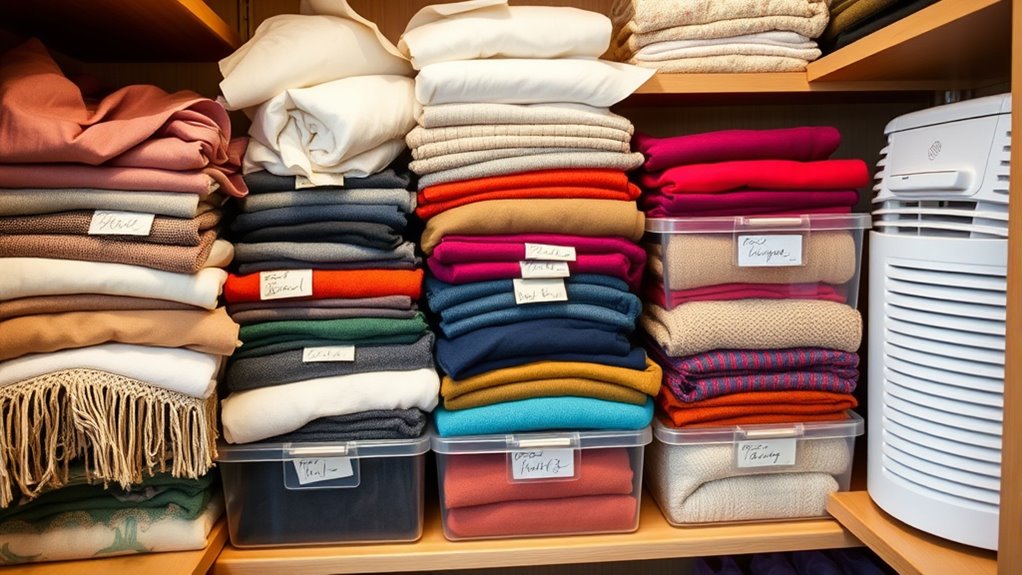To store seasonal fabrics safely, choose breathable fabric bags or sturdy plastic containers with tight lids, avoiding cardboard boxes. Clean and fully dry your fabrics before folding them carefully, and use acid-free tissue to prevent color transfer and damage. Keep containers in cool, dark, and dry spots, adding silica gel packs if needed. Regularly check for pests or deterioration to maintain their quality. For more tips on long-term storage, explore further details below.
Key Takeaways
- Use breathable fabric bags or sturdy plastic containers with tight lids, avoiding cardboard boxes.
- Clean and completely dry fabrics before storage to prevent mold and mildew growth.
- Fold fabrics carefully, pad delicate items with acid-free tissue, and label containers clearly.
- Store in a cool, dry, dark space away from direct sunlight, maintaining stable temperature and humidity.
- Regularly inspect stored fabrics for pests or damage and address issues promptly to preserve quality.

Storing seasonal fabrics properly is vital to keep them in good condition for next year’s use. When you’re done with your seasonal fabrics, whether it’s winter wool or summer linens, making sure they’re preserved correctly prevents damage and extends their lifespan. The key to effective fabric preservation lies in selecting the right storage containers. Opt for breathable fabric bags or sturdy plastic containers with tight-fitting lids to shield your fabrics from dust, moisture, and pests. Avoid cardboard boxes, as they can attract insects and don’t provide a reliable barrier against humidity.
Before placing your fabrics into storage, give them a thorough clean. Dirt, oils, or stains left on fabrics can cause deterioration over time. Washing or dry cleaning your items ensures they’re free of debris that might attract pests or cause fabric degradation. Make sure everything is completely dry before packing, as moisture can lead to mold or mildew growth during storage. Once cleaned and dried, fold your fabrics carefully to prevent creases, avoiding overly tight folds that might cause permanent creases or weaken fibers. Use acid-free tissue paper to pad delicate fabrics or to maintain their shape, especially for items like lace or silk.
Thoroughly clean and dry fabrics before storage to prevent damage and deterioration over time.
When packing, consider layering fabrics with acid-free tissue paper to prevent color transfer and fabric abrasion. Place the folded fabrics neatly inside your chosen storage containers, filling any gaps to prevent shifting. Keep heavier items at the bottom of the container and lighter ones on top. Label each container clearly with the contents and the date of storage. This makes it easier to locate what you need later and ensures you rotate your seasonal fabrics properly, inspecting them periodically for signs of pests or damage. Incorporating proper storage conditions such as temperature and humidity control can significantly extend the lifespan of your fabrics.
Temperature and humidity control are vital. Store your containers in a cool, dry, and dark space, such as a closet or attic, away from direct sunlight or fluctuating temperatures. Light can fade colors, and humidity encourages mold growth. If you live in a humid climate, consider adding silica gel packs to your storage containers to absorb excess moisture. Regularly check your stored fabrics for signs of pests or deterioration. If you spot any issues early, address them promptly to prevent further damage.
Frequently Asked Questions
How Can I Prevent Fabric Discoloration During Storage?
To prevent fabric discoloration during storage, you should guarantee your fabric is properly cleaned before storing. Use gentle fabric cleaning methods to remove dirt and oils that can cause staining or fading. Store your fabrics in a cool, dark, and dry environment, away from direct sunlight and humidity. Proper storage conditions and clean fabrics help preserve their color, ensuring they stay vibrant and undamaged over time.
What Are the Best Natural Repellents for Moth Protection?
Moth prevention starts with natural repellents that really work. You can use cedarwood chips or blocks, which emit a scent moths dislike. Lavender sachets are also excellent; they leave a pleasant aroma while warding off unwanted pests. Additionally, bay leaves and herbal herbs like rosemary or thyme serve as natural repellents. Keep these items hidden among your fabrics to create a pest-proof, fragrant fortress for your seasonal fabrics.
How Often Should I Check Stored Fabrics for Damage?
You should check your stored fabrics at least once every three months to catch any fabric mold or insect infestation early. Regular inspections help you spot signs of damage, like discoloration or small holes, before they worsen. If you notice any issues, promptly address them by cleaning or treating the fabrics. Consistent checks keep your seasonal fabrics in good condition and prevent long-term damage from mold or pests.
Can I Store Fabrics in Plastic Bins Long-Term?
You can store fabrics in plastic bins long-term, but consider durability and breathability. Plastic bins are durable and protect against pests and moisture, but they trap humidity, risking mold and fiber damage. Only use sturdy, ventilated bins or add breathable fabric covers inside. Statistically, 60% of fabric damage occurs due to improper storage, so choosing the right container helps preserve your textiles and keeps them in top condition for future use.
What Are Eco-Friendly Alternatives to Traditional Storage Methods?
You can opt for eco-friendly storage by using biodegradable containers, which break down naturally and reduce environmental impact. Reusable fabric covers are also a great choice—they protect your fabrics while being sustainable. These alternatives not only help the planet but also keep your seasonal fabrics safe from damage. By choosing biodegradable containers and reusable covers, you contribute to eco-conscious living and make certain your fabrics stay in excellent condition year after year.
Conclusion
Storing your seasonal fabrics properly is like giving them a cozy winter coat—they’ll stay protected and fresh for next year. I once stored my wool sweaters in plastic bags, only to find moth holes the following season. Now, I use breathable storage, and they stay pristine. Remember, a little care now saves you from costly repairs later. Treat your fabrics like treasured friends, and they’ll reward you with years of beauty and comfort.









